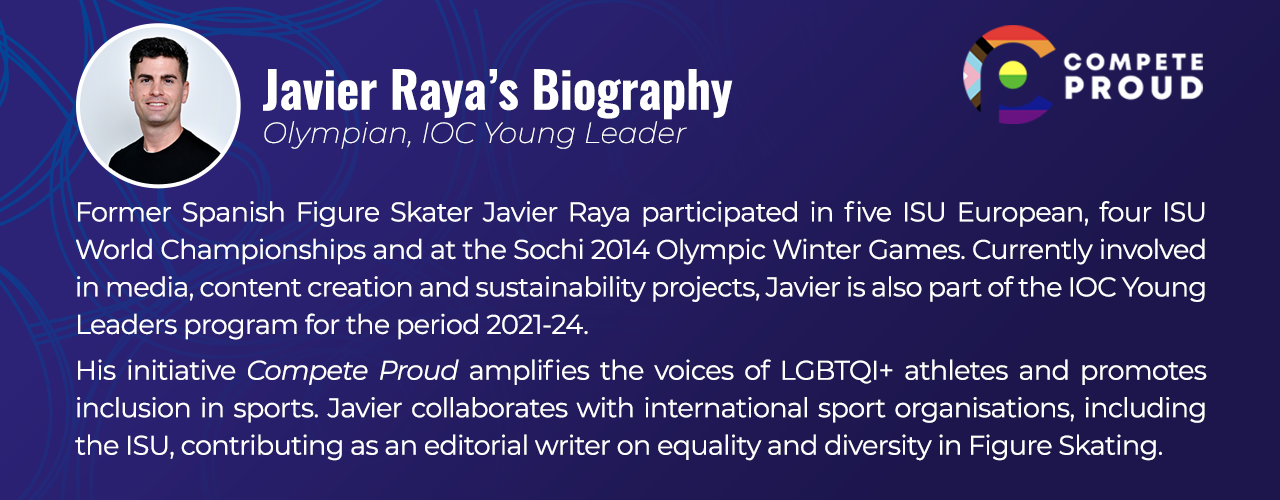
_WFSC_Saitama%20(JPN)-1249434253.jpg)
Laurence Fournier Beaudry and Nikolaj Soerensen (CAN) react during the 2023 ISU World Figure Skating Championships in Saitama (JPN) @Getty Images
Canadian Ice Dancers and silver medalists at the 2023 ISU Four Continents Figure Skating Championships, Laurence Fournier Beaudry and Nikolaj Sorensen acknowledge that there is still more to be done behind the scenes to achieve true equity and diversity in the sport.
In a sport as artistically unique as Figure Skating, a sense of balanced gender equality is portrayed when a woman and a man skate together in the Ice Dance and Pairs categories. And while some elite skaters will have careers that take them to the world stage, others still struggle with gender inequity that threaten their dream due to lack of opportunities.

Laurence Fournier Beaudry and Nikolaj Soerensen (CAN) pose at the 2023 ISU Four Continents Championships in Colorado Springs (USA). @ISU
Looking back to where it all began
When we think about elite athletes and their successful paths to the top, we sometimes tend to underestimate their passion for the sport and the many sacrifices they did to reach their goals.
For Nikolaj Sorensen, as a kid growing up in Denmark, choosing Figure Skating meant facing many barriers already at a young age and breaking stereotypes at school just for practicing a sport different from the norm in a Scandinavian winter sports country.
_ISU%20Grand%20Prix_GettyImages-1448003281.jpg)
Laurence Fournier Beaudry and Nikolaj Soerensen (CAN) compete at the ISU Grand Prix Final in Torino (ITA) @ISU
“I started in Figure Skating at the age of 6, initially as a single skater, and I remember I used to be the only boy skating among a group of 10 girls all the way up to the age of 11” said Sorensen.
“I remember I used to go to school where even some of my friends were questioning what I was doing, sometimes ‘teasing’ me about it,” he added.
Nikolaj's testimony is not uncommon when looking at the huge imbalance that has existed in Figure Skating since its beginnings . There are certainly a multitude of reasons explaining the difference in the number of boys and girls entering the sport, but this gap turns out to be a constant problem even in those countries where winter sports predominate.
“I consider myself lucky for having the most amazing parents, as they gave me the confidence and strength to continue in Figure Skating,” said Sorensen.
“Some days were tougher than others, and I remember that especially by the age of 13 or 14 some people questioned why I was not playing soccer or hockey. So yes, sometimes I felt like quitting because I felt it was not worth it” he continued.
Competitiveness and teaming up
The lack of boys in Figure Skating from an early age means there are more girls than boys looking for partners. This translates later into greater difficulty for girls to find a male skating partner in Ice Dance and Pairs, creating a fierce process.
_ISU%20Grand%20Prix_Torino%20(ITA)-1448189450.jpg)
Laurence Fournier Beaudry and Nikolaj Soerensen (CAN) compete during the ISU Grand Prix Final in Torino (ITA) @ISU
"I remember one time I went to Ontario (CAN), where there were only three guys trying out with maybe twelve girls," Fournier said. "So this is where you clearly have a different ratio that involves competitiveness, because you feel like you're really being compared to be the perfect one, to be the chosen one."
This competitiveness clearly becomes a limiting factor the higher the level. For many girls this has become a point of no-return, with many giving up in their efforts to find the right partner after tireless unsuccessful attempts.
"It happens that if you don't find the right partner in one or two years at the most, a lot of girls end up quitting," Laurence Fournier Beaudry explains.
Coming with that competitiveness issue are various forms of pressure that affect girls entering and growing into the sport:
“As a girl in Ice Dance you have to be good at skating skills, you have to look good, you have to be in good shape” underlines Fournier. “And especially at the age of 15 or 16 when the girls hit puberty and grow, it is quite difficult as you have to understand your body and your needs.”
"I think as a guy in Ice Dance you're judged a little less because people want to keep you in the sport," Sorensen said, "whereas with girls, I think often, especially when they're young, there's a little more pressure on them."
_ISU%20Grand%20Prix_Torino(ITA)-1448035883.jpg)
Laurence Fournier Beaudry and Nikolaj Soerensen (CAN) react at the ISU Grand Prix Final in Torino (ITA) @Getty Images
The required funding needed to practice Figure Skating can also be a barrier for many as the financial return on investment is incomparable to other sports such as ice hockey or soccer which are financially more affordable and generally more accessible.
"I would say the investment is even greater in North America than in Europe, as in Europe it tends to be group lessons versus private lessons, so it's more affordable." Sorensen said.
"But still, it's certainly a limiting factor for many families with multiple children because of the price of practicing our sport and the potential to make a living in skating even when you are top 3 in the world."
Finding solutions and new opportunities
What are potential options to consider to improve equal opportunities for both genders with a particular focus on Ice Dance and Pairs?
Sorensen considers that coaching approaches may play a decisive role:
"It depends on the coaches, as I came to Montreal (CAN) and they treated us equally. It's a different approach to the sport," he concluded.
Relocation options also open up new teaming up possibilities. Usually girls are going the extra mile or making an economic effort to make it work by moving to a new country or city, or covering living and training expenses.
"When we talk about teaming up two skaters from different cities or countries, it's mostly the girls who would have to relocate," Laurencer said. "Otherwise, it's pretty rare, although Nik did it."
“In my case, I moved once for my American partner, where the cost was substantially higher than in Canada, and I had big discussions with my parents about what I could do," continued Laurence.
"They really wanted to be behind me, giving me the opportunity to continue and succeed doing what I love, for which I will be eternally grateful to them, even though I stayed there 2 months and I don't even know if I could have afforded it for a long period of time" she added.
"Financially, Figure Skating can be a real trigger, a problem and a cause to quit."
"That's the other thing, which sometimes shows even more the inequality between a woman and a man in Ice Dancing," Sorensen said, "I don't think there are many guys who paid to find a partner, even if it was like the best in the world."
There are also more and more ways put in place facilitating the search for a partner.
"Something that helps in Canada is when a coach comes or when there's a skating show and parents see it. There's usuallysomeone in the club, an Ice Dancer, teaching or doing a seminar, and it increases their popularity," Laurence said. "It raises awareness."
“In Quebec, for example, they do guys seminars, where all the guys in the province get together and then there are some coaches teaching," Laurence continued, "so it brings that kind of energy that they might be looking for, seeing other guys like them."
_WFSC_Saitama%20(JPN)-1476107190.jpg) Laurence Fournier Beaudry and Nikolaj Soerensen (CAN) compete during the ISU World Figure Skating Championships in Saitama (JPN) @ISU
Laurence Fournier Beaudry and Nikolaj Soerensen (CAN) compete during the ISU World Figure Skating Championships in Saitama (JPN) @ISU
Striving to provide new opportunities for individuals to embrace the sport, Skate Canada has introduced a broader definition of “team”.- initially designated by one woman and one man - that “consists of two skaters” regardless of their gender identities.
This new recommendation made by Skate Canada's Equity, Diversity, Inclusion and Accessibility (EDIA) Operating Committee was endorsed on July 2022 and unanimously accepted by Skate Canada Board of Directors in September 2022, This change will allow for new forms of Pairs and Ice Dance partnerships competing at the national level.
"I think it just sends a message that Figure Skating in Canada is really open and that it aligns with the values of the country, which to me has proven to be a really inclusive country," Sorensen said.
"I believe what they're trying to achieve is to let everybody be a part of the sport, no matter what size or shape," Sorensen continued, "and I'm very proud of that."

.png)
